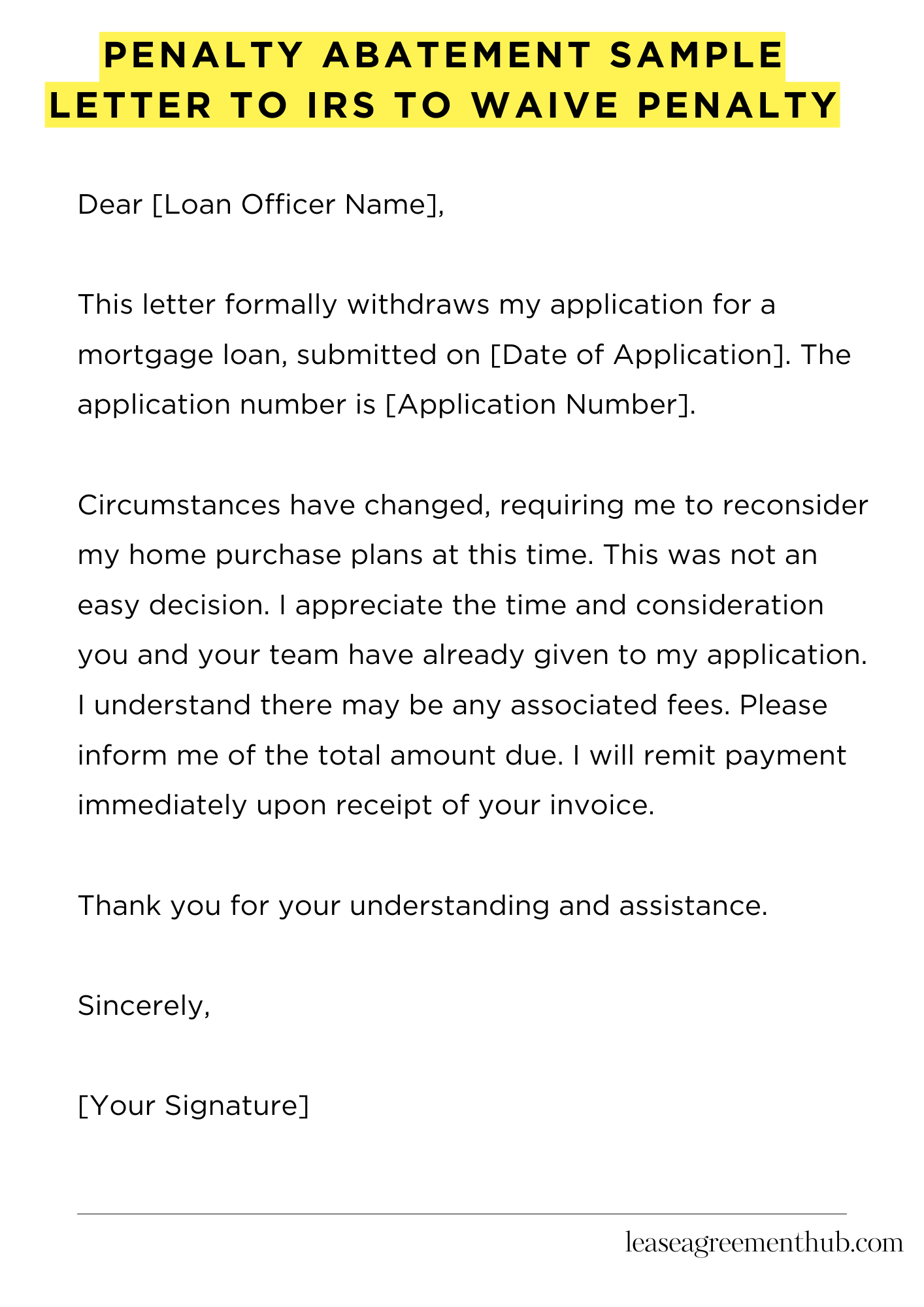Facing an IRS penalty? A penalty abatement letter asks the IRS to forgive it. It explains why you deserve leniency.
This article gives you examples. We share sample penalty abatement letters. These will help you write your own. Use them as templates.
You’ll find various examples. They cover different situations. These help ensure your letter is effective.
Penalty Abatement Sample Letter to IRS to Waive Penalty
[Your Name]
[Your Address]
[Your Phone Number]
[Your Email Address]
[Date]
Internal Revenue Service
[IRS Address]
Subject: Penalty Abatement Request – Taxpayer Identification Number [Your TIN]
Dear Sir/Madam,
This letter formally requests abatement of penalties assessed against my tax account, [Your TIN]. I understand my tax obligations and regret the late filing/payment. Circumstances beyond my control caused this oversight.
Specifically, [Clearly and concisely explain the reason for the late filing or payment. Be factual and avoid emotional language. Provide supporting documentation if possible. For example: “I experienced a serious illness requiring extensive hospitalization and medical treatment, preventing me from timely filing my return.” or “Due to a sudden and unexpected job loss, I faced significant financial hardship that made timely payment impossible.”].
The attached documentation supports my claim. I have since filed my return and made the necessary payments in full. I believe the penalty is excessive given the circumstances. I respectfully request your consideration in waiving the penalty.
Prompt resolution of this matter is greatly appreciated. Thank you for your time and attention to this request. I look forward to your response.
Sincerely,
[Your Signature]

How to Write a Penalty Abatement Sample Letter to the IRS to Waive Penalty
Understanding IRS Penalties
Penalties levied by the IRS can be substantial. These pecuniary sanctions arise from various infractions, from late filing to underpayment. Understanding the specific penalty applied to your situation is paramount before crafting your abatement request. Scrutinize your notice meticulously for the penalty code. This code unlocks the reason for the penalty and informs your argument for abatement.
Building a Strong Case for Abatement
The IRS grants penalty abatement for reasonable cause. This necessitates a cogent and well-documented explanation. Valid reasons frequently encompass unforeseen circumstances beyond your control. Consider providing corroborating evidence like medical records or documentation of a natural disaster. A compelling narrative strengthens your claim.
Structuring Your Penalty Abatement Letter
Begin your letter with your full name, address, Social Security number, the tax year in question, and the relevant notice number. State clearly your intention to request penalty abatement. Maintain a respectful and professional tone throughout the correspondence.
Articulating Your Reasonable Cause
Forthrightly explain the circumstances that led to the penalty. Provide a chronological account of events. Eschew ambiguity; clarity is crucial. Include specific dates, amounts, and any other pertinent details. Substantiate your claims with documentary evidence whenever feasible.
Including Supporting Documentation
Attach copies of any supporting documents. Never send original documents. Organize these attachments logically and refer to them explicitly in your letter. This meticulous approach enhances the IRS’s ability to process your request expeditiously.
Submitting Your Letter and Following Up
Send your letter via certified mail with return receipt requested. This provides proof of delivery and safeguards against misplacement. Retain a copy of your letter and all attachments for your records. Allow ample processing time. If you haven’t received a response within a reasonable timeframe, follow up with the IRS via telephone or mail.
Utilizing Professional Assistance
Navigating IRS procedures can be daunting. If you find the process overwhelming, consider engaging a tax professional. Enlisting the expertise of a Certified Public Accountant (CPA) or an Enrolled Agent (EA) can provide invaluable guidance and significantly augment your chances of a successful abatement. Their specialized knowledge of tax law can be instrumental in navigating the intricacies of penalty abatement.
FAQs about penalty abatement sample letter to IRS to waive penalty
Requesting penalty abatement from the IRS requires careful consideration and a well-crafted letter. Understanding the process and common questions can significantly improve your chances of success.
What information should my penalty abatement letter include?
Your letter should clearly state your intention to request penalty abatement. It must include your name, address, taxpayer identification number (TIN), the tax year(s) involved, the specific penalty you’re contesting, the amount of the penalty, and a detailed explanation of why you believe the penalty should be waived. Include all relevant documentation supporting your claim, such as evidence of reasonable cause for non-payment or filing.
What constitutes “reasonable cause” for penalty abatement?
Reasonable cause is a broad term that generally refers to circumstances beyond your control that prevented timely payment or filing. Examples include serious illness, natural disasters, death of a family member, or unforeseen circumstances that significantly impacted your ability to meet your tax obligations. The IRS requires substantial documentation to prove reasonable cause.
Should I use a sample letter or draft my own?
While using a sample letter can provide a useful framework, it’s crucial to customize it to your specific situation. A generic letter may not adequately address the nuances of your case and could weaken your request. Tailoring your letter to include specific details and supporting documentation is vital for a successful abatement.
What is the likelihood of the IRS granting penalty abatement?
The likelihood of success depends heavily on the strength of your case and the documentation you provide. Clearly demonstrating reasonable cause significantly increases your chances. However, the IRS has the final authority and may deny your request even with compelling evidence. Careful preparation and a well-written letter are essential.
What should I do if my penalty abatement request is denied?
If your request is denied, you can consider appealing the decision. You’ll need to follow the IRS’s appeals process, which typically involves submitting a formal appeal and potentially attending an informal conference or hearing. It’s advisable to seek help from a tax professional if your appeal is denied.
Related: